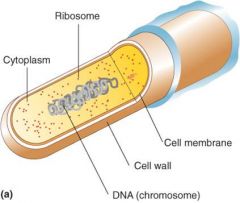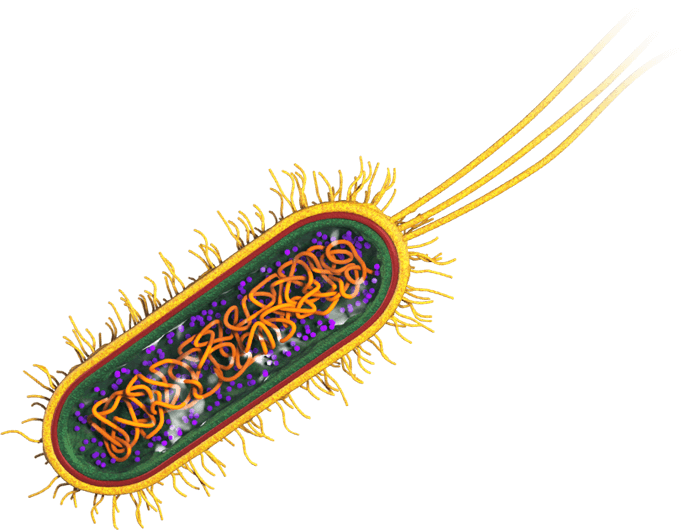38 bacterial cell without labels
Morphology, Different shapes of bacterial cell - BYJUS Different shapes of a bacterial cell are: Spherical- Cocci. Rod-shaped- Bacilli. Spiral bacteria. Comma shaped- Vibrio. 1. Spherical- Cocci: Cocci can be single or multiple in a group of 2, 4, 8, etc. Cocci bacteria can be round, oval or elongated or bean-shaped. The cell wall of coccus shaped bacteria may be gram-positive with thick ... Stains - Microbiology Resource Center - Truckee Meadows ... - TMCC Almost all bacteria can be divided into two groups, Gram negative or Gram positive. A few bacteria are gram variable. Trichomonas, Strongyloides, some fungi, and some protozoa cysts also have a Gram reaction. Very small bacteria or bacteria without a cell wall, such as Treponema, Mycoplasma, Chlamydia, or Rickettsia do not have a gram reaction. The characterization of any new bacteria must include their gram reaction.
"Raised Without Antibiotics" Labels Found to be Misleading There is growing concern about whether our antibiotics can keep pace with the threats posed by new and emerging bacterial pathogens. Already, it's estimated that 700,000 people around the world die every year from antibiotic resistant infections, and scientists and experts have been warning that the problem will only get worse in the future. As such, there is pressure to limit the use of ...

Bacterial cell without labels
Bacterial Identification | 8 Methods & Tests In Microbiology - Study Read Identification by morphology: This method is to determine the individual bacterial physical appearance. 1. Based on size. Here bacteria are identified based on their physical size. Like small size or big one expressed in microns. For this bacteria are viewed under a microscope to view the size. Classical Labeling of Bacterial Pathogens According to Their Lifestyle ... Furthermore, in some intracellular pathogens like T. whipleii, the presence of intact cells promotes extracellular bacterial growth when co-cultured in vitro with cells (La Scola et al., 2001). The presence of large aggregates of bacteria including dividing cells in these culture supernatants suggested that T. Structure of Bacterial Cell (With Diagram) - Biology Discussion Capsule: It is an outer covering of thin jelly-like material (0.2 μm in width) that surrounds the cell wall. Only some bacterial species possess capsule. Capsule is usually made of polysaccharide (e.g. pneumococcus), occasionally polypeptide (e.g. anthrax bacilli) and hyaluronic acid (e.g. streptococcus).
Bacterial cell without labels. Different Size, Shape and Arrangement of Bacterial Cells Size of Bacterial Cell. The average diameter of spherical bacteria is 0.5-2.0 µm. For rod-shaped or filamentous bacteria, length is 1-10 µm and diameter is 0.25-1 .0 µm. E. coli , a bacillus of about average size is 1.1 to 1.5 µm wide by 2.0 to 6.0 µm long. Spirochaetes occasionally reach 500 µm in length and the cyanobacterium. Cell Structure With Labels Teaching Resources | Teachers Pay Teachers A worksheet of a bacterial cell that students can label independently or with teacher guidance. The diagram could be used in assessment too rather than just as a class activity. Students can also find the function of the organelles and add 3 more organelles to the diagram (mesosome, flagellum and capsule)There is an answer sheet included. Designer label for a bacterial cell 'jacket' - University of Delaware Designer label for a bacterial cell 'jacket' Article by Tracey Bryant Photo by Evan Krape May 23, 2017. Video courtesy of Grimes Laboratory and Bio-Imaging Center. ... which would use it to build its jacket without affecting anything else," Grimes explained. "Once the label was incorporated, we figured we could put 'flashlights' on it ... The Bacterial Cell Envelope - PMC - PubMed Central (PMC) THE GRAM-NEGATIVE CELL ENVELOPE. After more than a decade of controversy, techniques of electron microscopy were improved to the point in which they finally revealed a clearly layered structure of the Gram-negative cell envelope (Fig. 1) (Glauert and Thornley, 1969).There are three principal layers in the envelope; the outer membrane (OM), the peptidoglycan cell wall, and the cytoplasmic or ...
Rapid identification of pathogenic bacteria using Raman ... - Nature Raman optical spectroscopy promises label-free bacterial detection, identification, and antibiotic susceptibility testing in a single step. However, achieving clinically relevant speeds and... Animal Cell Diagram Without Labels Structure - ACTUINDE The only exception is Mycoplasma bacteria that have no cell wall and consequently no particular shape. Bacteria diagram additionally shows Periplasmic space, that is a cellular compartment found merely in bacteria that have an outer membrane and a plasma membrane . 3d Animal Cell Model With Labels | Science cells, Teaching … (Nora Baldwin) Bacterial Cell No Labels clip art - Clker 1. Select a size, 2. Copy the HTML from the code box, 3. Paste the HTML into your website. Small Medium Large Derivatives & Responses Prokarytoci Cell Bacterial Cell: Structure and Components | Microbiology Bacterial cells (prokaryotic cells) are structurally much simpler than eukaryotic cells and the two cell types are compared in Table 3.2. They consists of various cell surface structures, cell wall, plasma membrane, many cytoplasmic inclusions, and the bacterial chromosome (nucleoid). Except some, all structures do not occur in every genus.
Bacteria in Microbiology - shapes, structure and diagram - Jotscroll Bacterial spores. Bacterial endospores layers. Bacteria cells are the smallest living cells that are known; even though viruses are smaller than bacteria, viruses are not living cells. There are different types of bacteria with various sizes, shapes, and structures. The bacteria shapes, structure, and labeled diagrams are discussed below. Bacteria Cell: Different Parts of a Generalized Bacteria Cell ... ADVERTISEMENTS: The different parts of a generalized bacteria cell have been-shown in Figure 2.3 and have been described as follows: 1. Flagella: Bacterial flagella are thin filamentous hair-like helical appendages that protrude through the cell wall and are responsible for the motility of bacteria. Most of the motile bacteria possess flagella. Its length is about […] Fast Label-Free Nanoscale Composition Mapping of Eukaryotic Cells Via ... Mapping the biochemical composition of eukaryotic cells without the use of exogenous labels is a long-sought objective in cell biology. Recently, it has been shown that composition maps on dry single bacterial cells with nanoscale spatial resolution can be inferred from quantitative nanoscale dielectric constant maps obtained with the scanning dielectric microscope. Bacteria Label Teaching Resources | Teachers Pay Teachers Plant Cell, Animal Cell, Bacteria Cell Structure Science Poster Labels Anatomy. by. Mrs Wonder's Classroom. $10.00. Zip. Bright colorful set of 3 science printable posters. Plant, Animal and Bacteria cell structure with labels to be used as educational art for any kid's playroom, classroom, Montessori or homeschooling areas.Science Printable ...
Bacterial cells - Cell structure - Edexcel - GCSE Combined Science ... Bacterial cells. Bacteria are all single-celled. The cells are all prokaryotic. This means they do not have a nucleus or any other structures which are surrounded by membranes. Larger bacterial ...
Cell Membrane Structure without labels - Pinterest Cell Membrane Structure without labels. Biology Pictures: Large collection of high quality biology pictures, photos, images, illustrations, diagrams and posters on marine biology, cell biology, microbiology... for educational purposes. ... This introduction to the structure of plant, animal and bacterial cells is accomplished with mobile ...
Breaking free of labels | Nature Reviews Microbiology Talà et al. took steps to minimize the phototoxicity of iSCAT to the bacterial cells by employing a relatively low energy (638 nm) laser that was shuttered to reduce the cell exposure.

How bacteria gets into a cell | Nursing students, Student planner, Medical laboratory scientist ...
Bacterial Cell Structure Labeling Diagram | Quizlet Bacterial Microcompartment. Protein coated packets used to localize enzymes and other proteins into the cytoplasm. Plasmid. Double-stranded DNA circle containing extra genes. Flagella. specialized appendage attached to the cell by a basal body that holds a long rotating filament. Pushes cell forward. Endospore.
Bacteria Under the Microscope - Microscope and Laboratory Equipment Reviews Mix the bacteria on the loop with the water you placed on the glass slide earlier and then flame your loop once again. Finally, allow the slide to air dry. Staining Procedure When looking at bacteria under the microscope much of the bacteria can appear transparent without staining. Staining allows different structural components of the cells to be visualized including the cytoplasm, cell wall, and membranes.
Introduction to Bacteria | Let's Talk Science Size of Bacteria. Bacteria are single-celled organisms. This means that each bacterium is made up of only one cell. This is very different from humans, whose bodies are made up of trillions of cells . Bacterial cells are much smaller than human cells. Bacterial cells can measure from about 1 to 10 μm long.
Bacteria: Cell Walls - General Microbiology 4 Bacteria: Cell Walls . It is important to note that not all bacteria have a cell wall.Having said that though, it is also important to note that most bacteria (about 90%) have a cell wall and they typically have one of two types: a gram positive cell wall or a gram negative cell wall.. The two different cell wall types can be identified in the lab by a differential stain known as the Gram stain.
Label-free bacterial imaging with deep-UV-laser-induced native ... A DUV (<250-nm) source enables the detection of microbes in their native state on natural materials, avoiding background autofluorescence and without the need for fluorescent dyes or tags. We demonstrate that DUV-laser-induced native fluorescence can detect bacteria on opaque surfaces at spatial scales ranging from tens of centimeters to ...
3 Common Bacteria Shapes - ThoughtCo Bacillus is one of the three primary shapes of bacteria. Bacillus (bacilli plural) bacteria have rod-shaped cells. These cells can exist in several different arrangements that include: Monobacillus: remains single rod-shaped cell after dividing. Diplobacilli: cells remain in pairs after dividing. Streptobacilli: cells remain in chains after dividing.
LevitasBio introduces label-free levitation technology - LevitasBio LevitasBio introduces a radical alternative for cell separation and sorting with label-free cell levitation technology. Today, LevitasBio has announced the commercial release of its flagship product - LeviCell TM - introducing a disruptive new method for cell researchers and scientists to sort live cells without the use of markers or ...
Structure of Bacterial Cell (With Diagram) - Biology Discussion Capsule: It is an outer covering of thin jelly-like material (0.2 μm in width) that surrounds the cell wall. Only some bacterial species possess capsule. Capsule is usually made of polysaccharide (e.g. pneumococcus), occasionally polypeptide (e.g. anthrax bacilli) and hyaluronic acid (e.g. streptococcus).
Classical Labeling of Bacterial Pathogens According to Their Lifestyle ... Furthermore, in some intracellular pathogens like T. whipleii, the presence of intact cells promotes extracellular bacterial growth when co-cultured in vitro with cells (La Scola et al., 2001). The presence of large aggregates of bacteria including dividing cells in these culture supernatants suggested that T.
Bacterial Identification | 8 Methods & Tests In Microbiology - Study Read Identification by morphology: This method is to determine the individual bacterial physical appearance. 1. Based on size. Here bacteria are identified based on their physical size. Like small size or big one expressed in microns. For this bacteria are viewed under a microscope to view the size.








Post a Comment for "38 bacterial cell without labels"